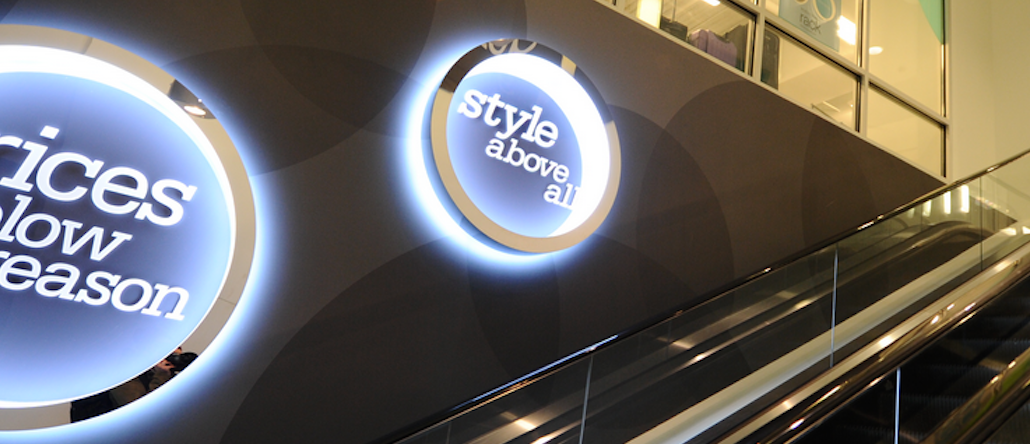
If you feel like Nordstrom Rack is everywhere, that’s because it is.
Nordstrom’s chain for discounted designer clothing and accessories is poised for a second consecutive year of growth, planning to open another 27 stores in 2015. Last year, it added the same number of new storefronts, which marked its biggest year of expansion yet.
According to Nordstrom’s 2014 annual report, Rack’s revenue increased by 17 percent; within the Nordstrom brand, Rack and its e-commerce store allotted for 27 percent of overall revenue. Rack’s online store launched in May of last year, joining the same purchasing platform as HauteLook, Nordstrom’s discount flash sale site.
Together, the two e-commerce legs have helped make Nordstrom Rack an unmatched force in the world of off-price department stores, and for Nordstrom, its aggressive off-brand strategy is paying off.
The flash-sale barrier of entry
When Nordstrom Rack’s full e-commerce store premiered online last year, the flash-sale HauteLook site had been up since 2007, running timed flash sales for marked-down products from designers like Steve Madden, Georgio Armani and Furla.
Its entry into the world of e-commerce was smart strategy for Nordstrom Rack, according to David Randolph, senior vp of retail and e-commerce at 360i. Randolph said that thanks to the low barrier of entry for a flash-sale site (there’s very limited overhead inventory involved in hosting one-off sales), it’s a great way for large retailers to dip their toes in the online market.

“There’s a huge capital investment in launching an outlet brand – stocking all the stores, hiring all the employees. And putting that online is hard,” said Randolph. “The flash sale site gave them a taste of standing up a new website before launching in the big time.”
A flash-sale site isn’t a far cry from a discounted outlet store to begin with, since flash-sale designer products are marked down and in limited quantity. When Nordstrom launched Rack’s e-commerce store, the company married the two online sites with the same payment platform and online shopping bag, creating a strong, cohesive e-commerce brand for Nordstrom Rack.
“The flash sale lets us learn a lot, and it’s an additional way to allow our customers to shop with us,” said Naomi Tobis, Rack’s public relations business manager. “They like the flash sale and the persistent catalog on the website and in stores. The online sites can also introduce new customers to Nordstrom and Rack.”
Seamless customer experience
Nordstrom Rack is how the Nordstrom brand invites younger, “aspirational” shoppers in without marginalizing the main department stores’ luxury appeal, and they’re also using their e-commerce legs to get online customers in stores.
The number of Nordstrom Rack stores are quickly outpacing the number of Nordstrom stores. By 2016, Rack is slated to have nearly double the storefronts as Nordstrom. Rather than dilute the Nordstrom brand, this speaks to the idea behind the outlet store itself, which is to be accessible for the price-conscious and millennial consumers, said Randolph.

To both earn the trust of its e-commerce shoppers and bring them in store, Nordstrom Rack eliminated a big risk of online shopping: Almost half of all e-commerce transactions are returned, according to Randolph. So, Rack made returns available in any store for online and HauteLook shoppers. In its annual report, Nordstrom said that 1 million customers made returns in-store of items they purchased online, meaning they were more likely to shop, avoiding closing the transaction after the return.
“It’s a Trojan horse to get people into stores,” said Randolph. “It creates a good atmosphere. If you return something, you’re more likely to walk around, shop and buy something else.”
Following consumer habits
According to Randolph, Nordstrom Rack’s e-commerce store’s existence is a testament to Nordstrom’s investment in the outlet. To launch a full online store worth shopping, the brand had to flesh out the distinction between Nordstrom and Rack, and dedicate merchants to stocking the brick-and-mortar and e-commerce stores.
Randolph also points out the rise of the luxury department store’s off-brand counterpart, citing similar brands like Saks Off Fifth and Barneys Warehouse: “It’s where the market is going.”
“You can either follow where the consumer crowd is going or you can dig your heels in and refuse to be anything but a high-end, premium brand,” he said. “That works for some. For Nordstrom, they need to attract a price-conscious consumer. And if you don’t follow [that consumer], you risk eliminating millennials.”
Nordstrom Rack is also following the elusive millennial consumer online.
The brand has its own social media accounts, separate from Nordstrom’s, on all the major platforms – Facebook, Twitter, Instagram, Snapchat and Vine – and, according to Tobis, uses interactions to fuel the Nordstrom Rack “treasure hunt.”
Tobis said that the online treasure hunt is helping customers find the products they post on social media and encouraging their followers to share what they’ve found online and in-store. On video platforms like Vine and Snapchat, they’re giving their followers behind-the-scenes glimpses at new store openings and seasonal products.
“Our focus is on being where our customers want to be,” said Tobis. “It’s a way to interact with them and find out what they’re interested in.”
More in Marketing

How marketers rank this year’s generative AI image, video tools
Digiday’s 2025 agency generative AI report card explores the winners and losers of the generative AI landscape.

In memoriam: Brands we lost in 2025
Digiday Media staff rounded up some of the most notable brand names we lost in 2025, like Joann and Rite Aid.

Pandora is betting on AI agents to scale service and emotional selling during the peak holiday season
Pandora is using AI agents to scale customer service and replicate emotional in-store selling online, just as peak season puts pressure on margins and teams.





